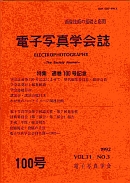Volume 31, Issue 4
Displaying 1-11 of 11 articles from this issue
- |<
- <
- 1
- >
- >|
-
1992Volume 31Issue 4 Pages 518-523
Published: 1992
Released on J-STAGE: June 06, 2007
Download PDF (751K) -
1992Volume 31Issue 4 Pages 524-530
Published: 1992
Released on J-STAGE: June 06, 2007
Download PDF (2969K) -
1992Volume 31Issue 4 Pages 531-541
Published: 1992
Released on J-STAGE: June 06, 2007
Download PDF (3180K) -
1992Volume 31Issue 4 Pages 542-548
Published: 1992
Released on J-STAGE: June 06, 2007
Download PDF (2542K) -
1992Volume 31Issue 4 Pages 549-557
Published: 1992
Released on J-STAGE: June 06, 2007
Download PDF (2073K) -
1992Volume 31Issue 4 Pages 559-566
Published: 1992
Released on J-STAGE: June 06, 2007
Download PDF (3346K) -
1992Volume 31Issue 4 Pages 567-571
Published: 1992
Released on J-STAGE: June 06, 2007
Download PDF (2842K) -
1992Volume 31Issue 4 Pages 572-577
Published: 1992
Released on J-STAGE: June 06, 2007
Download PDF (1467K) -
1992Volume 31Issue 4 Pages 578-584
Published: 1992
Released on J-STAGE: June 06, 2007
Download PDF (2657K) -
1992Volume 31Issue 4 Pages 585-590
Published: 1992
Released on J-STAGE: June 06, 2007
Download PDF (1829K) -
1992Volume 31Issue 4 Pages 591-598
Published: 1992
Released on J-STAGE: June 06, 2007
Download PDF (2038K)
- |<
- <
- 1
- >
- >|
